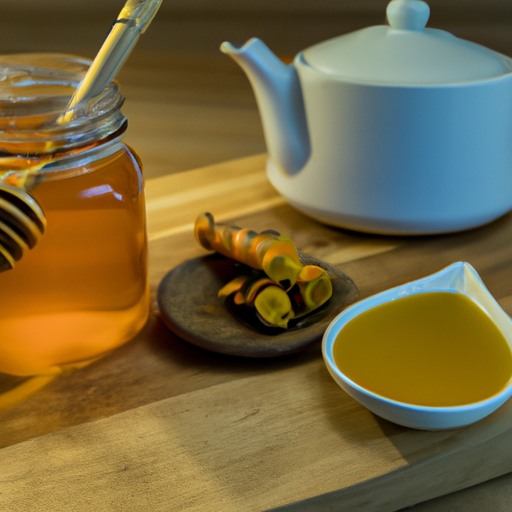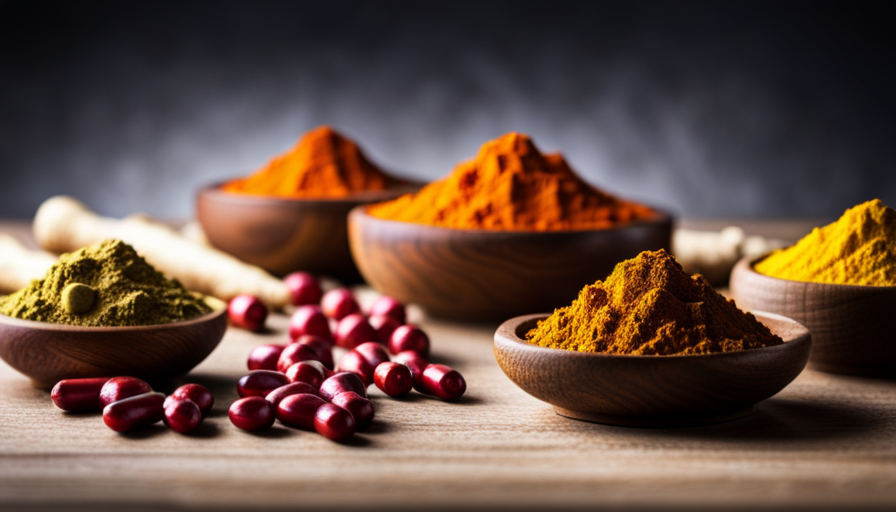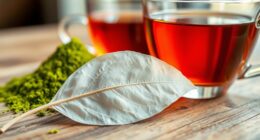I know what you might be thinking – turmeric tea? Really? But trust me, once you experience the incredible health benefits and delicious taste of this golden elixir, you’ll be hooked!
In this article, I’ll show you how to make turmeric tea using fresh turmeric root and a touch of honey for sweetness.
Turmeric has been used for centuries in Ayurvedic medicine for its powerful healing properties. It’s packed with antioxidants and anti-inflammatory compounds that can boost your immune system, improve digestion, and even reduce joint pain. And when combined with the natural sweetness of honey, it creates a soothing and nourishing beverage that is perfect for any time of day.
Making turmeric tea is surprisingly simple. You’ll start by preparing the turmeric root, then boil it in water along with a few other ingredients. After simmering and steeping, you’ll strain the tea and add a touch of honey to enhance the flavor.
So why not give it a try? Step into the world of turmeric tea and discover the wellness benefits that await you. Your body and taste buds will thank you!
Key Takeaways
- Turmeric tea is a delicious and nourishing beverage that offers numerous health benefits.
- Turmeric root can be grated and boiled in water with other ingredients to make turmeric tea.
- Honey can be added to turmeric tea for sweetness and additional health benefits.
- Turmeric tea can boost the immune system, improve digestion, and reduce joint pain.
Gather Your Ingredients
Now it’s time for you to gather all of your ingredients, so you can experience the warm, soothing goodness of turmeric tea with the perfect touch of honey. To make the most delicious turmeric tea, you’ll need a few key ingredients.
First and foremost, grab a fresh turmeric root from your local grocery store or farmer’s market. The beautiful golden color of turmeric comes from its active compound called curcumin, which is known for its numerous health benefits.
Next, make sure you have a jar of pure, raw honey. Honey not only adds a touch of sweetness to your tea but also provides its own set of health benefits, such as soothing a sore throat and boosting your immune system.
Once you have these two essential ingredients, you can get creative with the flavor variations. Some ideas include adding a slice of fresh lemon for a citrusy twist, or a pinch of cinnamon for a warm, cozy flavor. You can also experiment with other herbs and spices like ginger or cardamom to enhance the taste and aroma of your tea.
Now that you’ve gathered all your ingredients and have some ideas for flavor variations, let’s move on to preparing the turmeric root.
Prepare the Turmeric Root
First, peel and chop the turmeric root into small pieces. Turmeric root is a versatile ingredient that can be used in a variety of recipes. It not only adds a vibrant color to dishes but also provides numerous health benefits. Here are different ways to use turmeric root in recipes:
-
Grated: Grating the turmeric root allows you to easily incorporate it into dishes like stir-fries, curries, and soups. The small pieces of grated turmeric blend seamlessly with other ingredients, infusing the dish with its earthy flavor and golden hue.
-
Infused: Another way to use turmeric root is by infusing it in oils, vinegars, or even honey. This method enhances the flavor profile and allows you to add a touch of turmeric to dressings, marinades, and desserts.
-
Tea: Turmeric tea is a popular way to enjoy the benefits of turmeric root. Boil water and add the chopped turmeric root. Let it simmer for about 10 minutes to extract the flavors and compounds. This soothing tea can help boost your immune system, reduce inflammation, and aid digestion.
Preparing the turmeric root is just the first step in making turmeric tea. Now, let’s move on to boiling the water.
Boil the Water
To add a touch of elegance to your turmeric-infused creations, begin by bringing water to a gentle boil. Boiling water is a crucial step in making turmeric tea as it helps to release the flavors and nutrients from the herbs and spices. There are different methods you can use to boil water, such as using a stovetop kettle, an electric kettle, or a saucepan on the stove. Regardless of the method you choose, it’s important to let the water come to a gentle boil. This means that the water should be heated until small bubbles start to form, but it shouldn’t be boiling vigorously.
When making turmeric tea, using filtered water is highly recommended. Filtered water not only helps to enhance the taste and clarity of the tea but also removes impurities that may affect the overall quality. It ensures a clean and pure base for your tea, allowing the flavors of turmeric and other ingredients to shine through.
Now that the water’s gently boiling and you’ve chosen to use filtered water, you’re ready to move on to the next step of adding turmeric and other ingredients.
Add Turmeric and Other Ingredients
Once the water’s gently boiling, you’re ready to add in the turmeric and other flavorful ingredients. Turmeric root’s a versatile ingredient that can be used in various recipes, adding a vibrant color and distinct flavor.
Apart from making turmeric tea, you can incorporate turmeric root in soups, curries, and even smoothies for an extra nutritional boost.
To enhance the taste of your turmeric tea, you can experiment with alternative sweeteners like honey or maple syrup. These natural sweeteners not only add a touch of sweetness but also provide additional health benefits. Honey, in particular, has antioxidant and antimicrobial properties, making it a great choice for a holistic approach to wellness.
When adding the turmeric to the boiling water, make sure to use a fresh turmeric root, grated or finely chopped. This allows the flavors to infuse into the tea more effectively. Along with turmeric, you can also add other flavorful ingredients like ginger, cinnamon, or cardamom to enhance the taste and aroma of your tea.
As the turmeric and other ingredients blend together in the boiling water, the flavors will meld and create a delightful infusion. This process allows the tea to simmer and steep, unlocking the full potential of the ingredients.
Following this step, we’ll move on to the next section where we’ll discuss how to simmer and steep the tea to perfection.
Simmer and Steep
While the flavors meld together in the boiling water, the simmering and steeping process unlocks the full potential of the ingredients, resulting in a soothing and aromatic infusion that can provide numerous health benefits. As the turmeric root and other ingredients simmer and steep, their flavors infuse into the water, creating a rich and vibrant blend.
This infusion not only enhances the taste but also allows the beneficial compounds in turmeric to be released and absorbed more effectively by our bodies. Turmeric tea is well-known for its health benefits. The active compound in turmeric, called curcumin, is a powerful antioxidant and anti-inflammatory agent. When consumed regularly, turmeric tea can help reduce inflammation, boost the immune system, and support overall well-being. It’s also believed to have potential benefits for heart health, brain function, and even weight management.
Moreover, the simmering and steeping process also helps to release the natural oils and flavors from other ingredients like ginger, cinnamon, and black pepper, which further contribute to the taste and health benefits of the tea.
As the flavors meld together and the health benefits of turmeric tea are unlocked during simmering and steeping, the next step is to strain the tea and sweeten it to taste.
Strain and Sweeten
After the flavors have melded together and the vibrant infusion of turmeric and other ingredients has been achieved through simmering and steeping, it’s time to strain the tea and add a touch of sweetness to enhance the overall experience. Straining the tea removes any leftover bits of root or other ingredients, ensuring a smooth and enjoyable drink. To do this, place a fine mesh strainer over a teapot or mug and carefully pour the tea through it. The strainer will catch any solids, leaving you with a clear and flavorful liquid.
Now that the tea is strained, it’s time to sweeten it. While honey is a popular choice, there are several alternative sweeteners you can use to suit your taste and dietary preferences. Some options include maple syrup, agave nectar, or stevia. Experiment with different sweeteners to find the one that complements the flavors of the turmeric tea.
To help you choose the right sweetener, here’s a table comparing the taste, sweetness level, and health benefits of different alternatives:
| Sweetener | Taste | Sweetness Level | Health Benefits |
|---|---|---|---|
| Honey | Rich, floral | High | Antioxidant, antimicrobial |
| Maple Syrup | Earthy, woody | Medium-high | Minerals, antioxidants |
| Agave Nectar | Mild, caramel | Medium | Low glycemic index |
| Stevia | Mild, slightly | Very high | Zero calories, diabetic-friendly |
Now that you have strained and sweetened your turmeric tea, you are ready to enjoy your homemade creation. The next section will guide you on how to savor every sip of this delicious and nutritious beverage.
Enjoy Your Homemade Turmeric Tea
Indulge in the delightful experience of savoring your very own homemade turmeric elixir, allowing each sip to transport you to a world of vibrant flavors and nourishing goodness. Turmeric tea not only tastes amazing but also offers numerous health benefits. The star ingredient, turmeric, contains a compound called curcumin, known for its anti-inflammatory and antioxidant properties.
By incorporating turmeric tea into your daily routine, you can support a healthy immune system, reduce inflammation, and promote overall well-being.
There are various ways to prepare turmeric tea, depending on your taste preferences and desired health benefits. For a basic recipe, simply grate fresh turmeric root and steep it in boiling water for about 10 minutes. You can add a squeeze of lemon juice or a pinch of black pepper to enhance the absorption of curcumin. Another option is to mix turmeric powder with warm milk and honey for a soothing and creamy concoction.
To add more depth to your turmeric tea, you can experiment with different variations. Try combining turmeric with ginger for a spicy and invigorating blend. Or add cinnamon and nutmeg for a warming and comforting experience. With each variation, you’ll discover new flavors and potential health benefits.
So, sit back, relax, and enjoy the remarkable journey of sipping on your homemade turmeric tea. Embark on a holistic approach to wellness as you nourish your body with this golden elixir, packed with goodness and tantalizing flavors. Cheers to a healthier and more vibrant you!
Frequently Asked Questions
How long does it take for turmeric tea to show its health benefits?
Turmeric tea’s health benefits are like a slow dance, taking their time to reveal themselves. It usually takes a few weeks of sipping this golden elixir daily to experience its full effectiveness and feel its holistic power.
Can I use ground turmeric instead of fresh turmeric root?
Yes, you can use ground turmeric instead of fresh turmeric root in turmeric tea. However, there are some differences in flavor and health benefits. Ground turmeric has a more concentrated flavor but may have slightly reduced health benefits compared to fresh turmeric root.
Can I store the leftover turmeric tea for later use?
Yes, you can store leftover turmeric tea in the refrigerator for up to 2-3 days. When reheating, simply warm it on the stove or in the microwave. Remember to stir well before enjoying its numerous health benefits.
Are there any potential side effects of consuming turmeric tea?
Turmeric tea has some potential risks, including allergic reactions. However, when consumed in moderation, it can be beneficial for overall health. It’s important to consult with a healthcare professional before adding it to your routine.
Can I add milk or other spices to enhance the flavor of turmeric tea?
Adding milk to turmeric tea can enhance the flavor and provide additional health benefits. Spices like ginger or cinnamon can also be added to boost the taste and offer their own unique health properties.
Conclusion
In conclusion, making turmeric tea with root and honey is a simple yet effective way to incorporate the benefits of this powerful spice into your daily routine. By following the steps outlined in this article, you can create a delicious and nutritious beverage that promotes overall well-being. So why not give it a try?
Gather your ingredients, prepare the turmeric root, boil the water, add the turmeric and other ingredients, simmer and steep, strain and sweeten, and finally, sit back and enjoy your homemade turmeric tea. Cheers to a healthy and holistic lifestyle!










